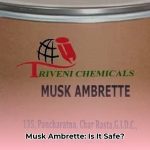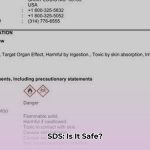What is Musk Ambrette?
Musk ambrette exists in two forms: synthetic and natural. Synthetic musk ambrette is a lab-created fragrance designed to mimic the aroma of natural musk, traditionally derived from the musk deer. This artificial version is cost-effective and bypasses ethical concerns related to animal products. However, potential health effects remain a topic of ongoing research. Natural ambrette seed oil, extracted from the hibiscus plant (Abelmoschus moschatus), offers a similar musky-floral scent but is chemically distinct from its synthetic counterpart.
Some studies suggest a link between synthetic musk ambrette exposure and early puberty. It’s hypothesized that the chemical may interact with the endocrine system, potentially disrupting hormone balance and triggering premature puberty. A National Institute of Environmental Health Sciences (NIEHS) study indicated that musk ambrette could increase gonadotropin-releasing hormone (GnRH) production, crucial for sexual development. This finding emphasizes the need for continued research.
Identifying synthetic musk ambrette can be challenging due to labeling practices. It often hides under generic terms like “fragrance” or “parfum.” Here’s where you might find it:
| Product Category | Examples |
|---|---|
| Cosmetics | Perfumes, lotions, makeup, hair products |
| Personal Care Products | Shampoos, conditioners, deodorants, body wash |
| Household Products | Certain detergents, air fresheners |
To minimize potential exposure:
- Scrutinize Labels: Carefully review ingredient lists for “fragrance,” “parfum,” or “musk ambrette.”
- Choose Fragrance-Free: Opt for fragrance-free products whenever possible.
- Consider Natural Alternatives: Look for products scented with essential oils or ambrette seed oil.
It’s important to note that natural musk and ambrette seed oil are chemically different from synthetic musk ambrette. Concerns primarily focus on the synthetic version. Some research suggests synthetic musk ambrette may act as an endocrine disruptor – a chemical that interferes with hormone function – though further study is needed.
The Research and Risks
Research on musk ambrette and its potential risks is ongoing. A primary concern is the possible link to early puberty, especially in girls. Researchers believe musk ambrette might interact with hormone receptors in the brain, potentially triggering premature hormone release.
Furthermore, studies have detected musk ambrette in human tissues, including maternal blood, umbilical cord blood, and breast milk, signifying potential exposure even before birth. The European Union has banned musk ambrette in cosmetics due to these concerns.
While these findings suggest caution, it’s important to remember that more research is needed to understand the long-term effects. Scientists are investigating exposure levels, mechanisms of action, and individual vulnerability.
Here’s a summary of key points:
| Feature | Description |
|---|---|
| Type | Synthetic musk (fragrance ingredient) |
| Potential Risk | Early puberty, hormonal disruption |
| Detection in Humans | Maternal blood, umbilical cord blood, breast milk |
| Regulatory Status | Banned in cosmetics by the European Union |
| Ongoing Research | Investigating long-term health effects, mechanisms of action, and safe exposure levels |
To minimize potential exposure:
- Read Labels: Check for “fragrance,” “parfum,” or “musk ambrette” on product labels.
- Go Fragrance-Free: Opt for fragrance-free products when available.
- Choose Natural Scents: Consider products with natural essential oils.
- Advocate for Transparency: Support initiatives promoting clearer labeling.
Products Containing Musk Ambrette
Musk ambrette, a synthetic musk often used for its cost-effectiveness, adds a sweet, powdery scent to various products. However, its potential health impacts, including a possible link to early puberty due to hormonal interaction, are under investigation. Scientists are studying these long-term effects on humans and the environment.
Identifying musk ambrette can be tricky due to labeling practices. Look for “fragrance” or “parfum,” which can mask its presence. It’s commonly found in:
- Perfumes and Colognes: Particularly discount or counterfeit fragrances.
- Personal Care Products: Soaps, shampoos, conditioners, deodorants, lotions, shaving creams, etc.
- Household Cleaners and Air Fresheners: Detergents, fabric softeners, cleaning sprays, air fresheners, candles.
- Cosmetics and Makeup: Scented foundations, powders, blushes, lipsticks, etc.
- Food Products (Less Common): Certain spices and flavorings.
Here’s a table summarizing common product categories:
| Product Type | Specific Examples |
|---|---|
| Perfumes & Colognes | Discount perfumes, body sprays, counterfeit scents |
| Personal Care Products | Soaps, shampoos, conditioners, deodorants, lotions, etc. |
| Household Products | Detergents, fabric softeners, cleaning sprays, air fresheners, candles |
| Cosmetics & Makeup | Foundations, powders, blushes, lipsticks, etc. |
| Foods (Less Frequent) | Certain spices, flavorings |
To reduce your exposure:
- Become a Label Detective: Scrutinize labels for “fragrance,” “parfum,” or “musk ambrette.”
- Choose Fragrance-Free: Opt for fragrance-free alternatives whenever possible.
- Support Transparent Brands: Look for companies that clearly list all ingredients.
- Stay Informed: Research ongoing studies related to musk ambrette.
While a comprehensive list of all products containing musk ambrette is unavailable due to labeling practices and market volume, ongoing research aims to provide a clearer understanding of its long-term health effects.
Minimizing Your Exposure
Here are some actionable steps you can take to reduce your and your family’s exposure to musk ambrette:
- Become a Label Detective: Look for musk ambrette, synthetic musk, or the generic terms “fragrance” and “parfum” on product labels.
- Choose Fragrance-Free Options: Opt for unscented versions of everyday products.
- Improve Ventilation: When using products containing fragrances, open windows or use a fan to circulate the air.
- Advocate for Clearer Labeling: Support initiatives promoting transparency in product labeling.
Frequently Asked Questions (FAQ)
| Question | Answer |
|---|---|
| Is musk ambrette an endocrine disruptor? | Research suggests it may interfere with hormone function, but more studies are needed. |
| Are there safe levels of exposure? | Currently, no official safe exposure limits exist for musk ambrette regarding puberty. |
What’s Next?
Research on musk ambrette is ongoing. As scientists learn more, regulations might change. Stay informed by consulting reliable sources like the National Institutes of Health (NIH) and consumer protection organizations.
Resources and Further Reading
- [National Institute of Environmental Health Sciences (NIEHS)] (add relevant NIEHS link here if available, otherwise remove)
Note: This information is for educational purposes and does not substitute professional medical advice. Consult a healthcare professional for specific health concerns.
- Water Mill Electricity Generator Provides Free Home Power - December 16, 2025
- Water Wheel Electric Generator Provides Free Home Electricity - December 15, 2025
- Choosing the Right Portable Hydro Turbine for Your Needs - December 14, 2025
















